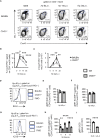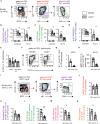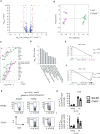Chitinase-3-like 1 regulates TH2 cells, TFH cells and IgE responses to helminth infection
- PMID: 37575256
- PMCID: PMC10415220
- DOI: 10.3389/fimmu.2023.1158493
Chitinase-3-like 1 regulates TH2 cells, TFH cells and IgE responses to helminth infection
Abstract
Introduction: Data from patient cohorts and mouse models of atopic dermatitis, food allergy and asthma strongly support a role for chitinase-3-like-1 protein (CHI3L1) in allergic disease.
Methods: To address whether Chi3l1 also contributes to TH2 responses following nematode infection, we infected Chi3l1 -/- mice with Heligmosomoides polygyrus (Hp) and analyzed T cell responses.
Results: As anticipated, we observed impaired TH2 responses in Hp-infected Chi3l1 -/- mice. However, we also found that T cell intrinsic expression of Chi3l1 was required for ICOS upregulation following activation of naïve CD4 T cells and was necessary for the development of the IL-4+ TFH subset, which supports germinal center B cell reactions and IgE responses. We also observed roles for Chi3l1 in TFH, germinal center B cell, and IgE responses to alum-adjuvanted vaccination. While Chi3l1 was critical for IgE humoral responses it was not required for vaccine or infection-induced IgG1 responses.
Discussion: These results suggest that Chi3l1 modulates IgE responses, which are known to be highly dependent on IL-4-producing TFH cells.
Keywords: IL-4; IgE (immunoglobulin E); T follicular helper (T cell FH; T helper 2 (Th2) cells; enteric; germinal center; germinal center (GC) B cells; helminth.
Copyright © 2023 Curtiss, Rosenberg, Scharer, Mousseau, Benavides, Bradley, León, Steele, Randall and Lund.
Conflict of interest statement
The authors declare that the research was conducted in the absence of any commercial or financial relationships that could be construed as a potential conflict of interest.
Figures







References
Publication types
MeSH terms
Substances
Grants and funding
LinkOut - more resources
Full Text Sources
Molecular Biology Databases
Research Materials
Miscellaneous

